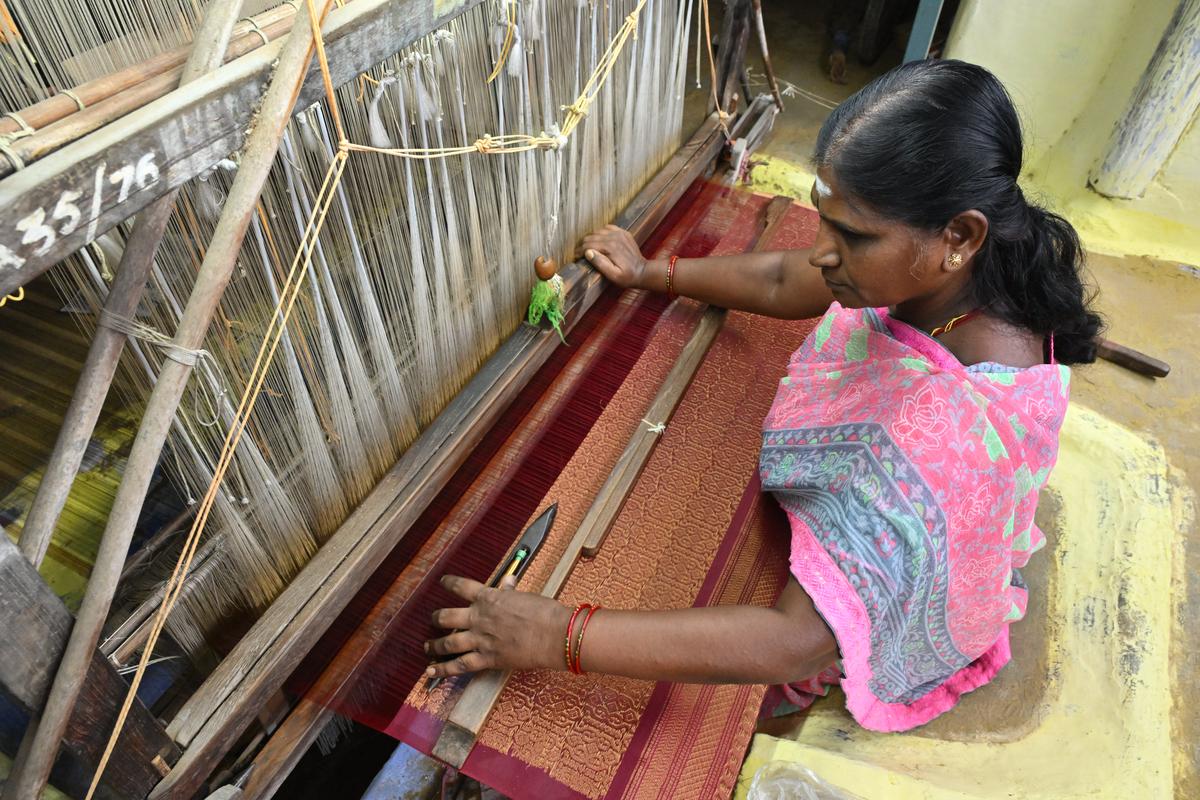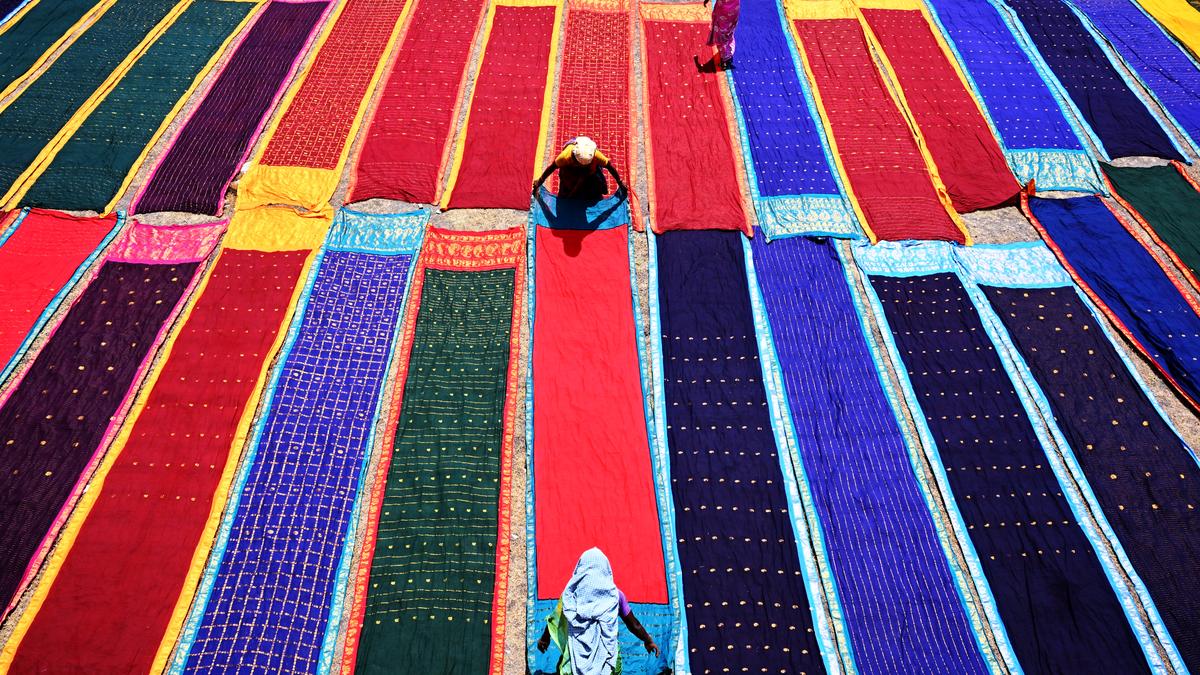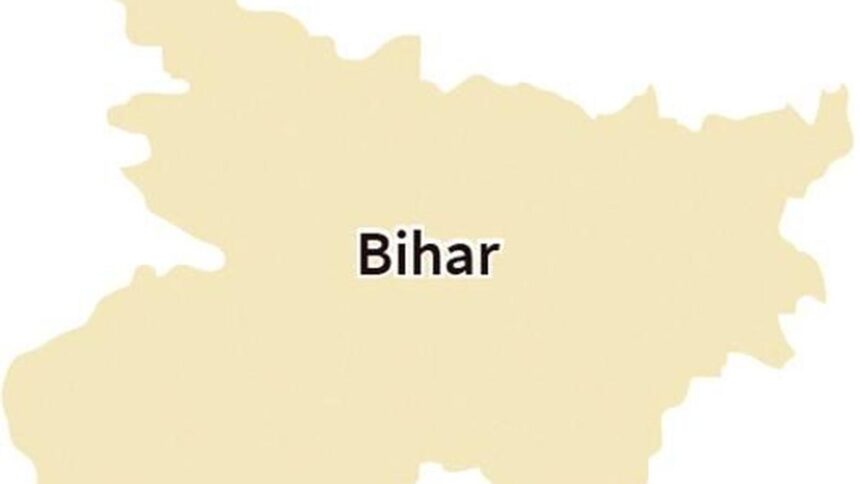Kodali Karuppur silk sari, a luxury garment once patronised by the Maratha kings of Thanjavur, derived its name from Karuppur, a village near Kumbakonam. The handwoven silk saris, dhotis, and furnishings of Karuppur that combined hand painting, block printing, and brocade-weaving were popular up to the 19th Century.
The Kovai Kora cotton saris that have Geographical Indication (GI) recognition are a blend of cotton and cold water-dyed silk. They are woven by weavers at Sirumugai in Coimbatore district.
As many as 1,001 men and 780 women weavers, who are members of the 70-year-old Thirubuvanam Silk Handloom Weavers Cooperative Production and Sale Society, make the Visiri Madippu (concertina fan-like fold) silk sari, another GI-tagged product that is a living heritage.
These and many more unique handwoven products dot the handloom map of Tamil Nadu. With 2.51 lakh registered handloom weavers, 35 clusters, and 11 GI-recognised handwoven products, the State has a rich legacy in hand-weaving cotton, silk, and blended fabrics.
From the world-renowned Kanchi silk to Bhavani Jamakkalam (carpet), weavers in Tamil Nadu make saris, dhotis, bedspreads, carpets, and even yoga mats and potli bags. Interestingly, the weaving activity is not restricted anymore to the homes of the weavers and cooperative societies. The State has a few start-ups too working in this space that are taking the handwoven saris and textile products to consumers across the country and abroad.
Yet, the number of handloom weavers is declining, their wages remain low, and several traditional skills in the handweaving process are almost lost.
A precarious situation
With changing times, a rise in overhead costs, including prices of raw materials, and a smaller number of skilled workers have created a precarious situation for those who remain in this vocation across the handloom clusters. The average earning of a cotton weaver in the State is ₹500 a day and for a silk weaver, it is ₹750.
A.K. Ramesh, a fifth-generation Sungudi artisan in Madurai, recollects how in the early 1960s, the narrow lanes around Thirumalai Nayakkar Mahal would resound with the click-clacking of the handlooms and the open yards in front of these houses would have people dyeing fabrics in vibrant colours. The women could be seen intricately twisting and knotting them for the unique tie-and-dye designs that have awed Sungudi connoisseurs for ages. There used to be about 50,000 handloom Sungudi weavers in Madurai, but today, that number has dwindled to 3,000, he says.
“Though we have the GI tag, a Kovai Kora cotton sari is sold for only ₹3,000, and a weaver earns only ₹1,100 for a sari. Hence, many of them have moved to soft silk saris,” says a manager at a cooperative society in Sirumugai.
“The demand has dropped drastically in the last three years. We have two looms — one to make Kora cotton saris for the society and another to make soft silk saris for private traders. My wife weaves Kora saris, and I weave silk saris. Together, we earn just about ₹12,000 a month,” says 56-year-old Bangaru Raju in Sirumugai.
Dwindling appeal
The situation is similar for weavers in almost all the handloom clusters and, hence, the trade no longer appeals to the next generation. The existing weavers are also shifting to products that are popular and remunerative.
In Madurai, except for a few select artisans, most of them get their greige fabric in bulk from Tiruppur. The only manual process that is involved is dyeing and the ubiquitous dots are now done by screen printing or by using moulds. Production is faster and the saris are sold from ₹700 each, depending on the designs. But for the few who still weave the cloth in handlooms and also make the intricate design painstakingly by hand, the labour cost has shot up as it takes almost 40 days to finish the tie-and-dye process. Thus, the price of the sari begins at ₹7,000.

A manager at a cooperative society in Sirumugai says though the Kovai Kora cotton sari has the GI tag, it is sold for only ₹3,000 a piece, and a weaver earns only ₹1,100 for a sari, and hence, many of them have switched to soft silk saris.
| Photo Credit:
S. Siva Saravanan
In Salem, there are very few weavers who are willing to make plain white silk fabric for shirting. “The demand for plain silk fabric for shirting is seasonal, and we cannot make other products because the loom is different,” said Ganesh, a weaver.
“The weavers will prefer to make products that are in demand. With schemes such as the mini-handloom parks, we try to reduce the cost for the weavers by developing worksheds and installing looms. Further, weaving is hard work and weavers work on a sari for two days. We are also taking measures to introduce more mechanisation,” said V. Amuthavalli, Principal Secretary, Handlooms, Handicrafts, Textiles and Khadi Department, Tamil Nadu.
“Consumers are willing to purchase saris worth even ₹50,000 online. Handwoven products should be seen as niche items that are known for their authenticity and can be purchased online too. All silk saris and dhotis that have original zari and are woven by the weavers for the societies have the zari authenticity card,” says Maheswari Ravikumar, Director of Handlooms, on the way forward for the handloom weavers.
New measures
A silk park has been established at Kancheepuram and one more is on the anvil at Arani. Four mini-handloom parks are functional in different parts of the State and six more are planned. A Handloom Scheme and cluster-development programmes are among initiatives that support the weavers in conserving traditional weaving skills, transitioning to new products and designs, and modernising the weaving activity.
There are plans to revive the skills needed to make the Kodali Karuppur saris. In Salem, while the Salem white silk has the GI tag, silk dhotis now come in multiple colours and patterns; and Palani saris have tie-and-dye designs.
Niche section of buyers
Pure handloom Sungudi saris, though costly, have also created a niche section of buyers. Social business ventures such as Tharagai Sungudi, run by like-minded women, are targeting these buyers.
“We hold exhibitions and apart from saris, we also showcase potli bags, pouches and tote bags made out of Sungudi fabric material. This value addition has helped many artisans,” says Sri Devi, one of the organisers.
The Madurai Sungudi sari was awarded the GI tag in December 2005 and it has added value and brought global attention to the product, adds Mr. Ramesh.
According to IPR attorney, P. Sanjai Gandhi, as many as 11 handloom products from Tamil Nadu have been registered so far for GI tag. Another nine new fresh applications have been filed.
Illam Thedi Pattu scheme
To attract more customers, the Thiurubuvanam Silk Cooperative will implement the Illam Thedi Pattu scheme in 2025-2026, which uses a mobile vending business model. In the Thanjavur Illam Thedi Pattu scheme, for the first time, 43 silk saris worth ₹16,85,244 were taken to the homes of customers in vehicles and four silk saris worth ₹1,27,734 were sold.
Ashok Jegadeesan and Prem Selvaraj, directors at Yaazh Naturals, Komarapalayam, exported handwoven yoga mats worth almost ₹7 crore in 2024-25. They have developed a smart yoga mat jointly with a Bengaluru-based company, as well as herbal-dyed silk saris.
“Weavers need to take the risk and venture into new products. The scope is high for exports. But they are reluctant to do so because they are not sure of the wages. The government should encourage such efforts,” says Mr. Jegadeesan.
Government support sought
While the cooperative societies and weavers have come out with new initiatives to take hand-woven products to more customers and make new products, they look for more support and encouragement from the government.
“The cost of living has increased manifold in the last 10 years. Several schemes, such as support for the education of children of weavers, are not available anymore. If we need to modernise our looms, the cost involved is high. It will be helpful if the government looks into these issues and supports us,” adds Mr. Bangaru Raju.
(With inputs from Nahla Nainar in Tiruchi, Beulah Rose in Madurai, and Sangeetha Kandavel in Chennai)























